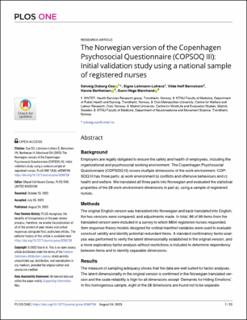| dc.contributor.author | Ose, Solveig Osborg | |
| dc.contributor.author | Lohmann-Lafrenz, Signe | |
| dc.contributor.author | Bernstrøm, Vilde Hoff | |
| dc.contributor.author | Berthelsen, Hanne | |
| dc.contributor.author | Marchand, Gunn Hege | |
| dc.date.accessioned | 2023-10-16T09:24:56Z | |
| dc.date.available | 2023-10-16T09:24:56Z | |
| dc.date.created | 2023-09-08T12:44:00Z | |
| dc.date.issued | 2023 | |
| dc.identifier.citation | PLOS ONE. 2023, 18 (8), e0289739-?. | en_US |
| dc.identifier.issn | 1932-6203 | |
| dc.identifier.uri | https://hdl.handle.net/11250/3096673 | |
| dc.description.abstract | Background
Employers are legally obligated to ensure the safety and health of employees, including the
organizational and psychosocial working environment. The Copenhagen Psychosocial
Questionnaire (COPSOQ III) covers multiple dimensions of the work environment. COP-
SOQ III has three parts: a) work environment b) conflicts and offensive behaviours and c)
health and welfare. We translated all three parts into Norwegian and evaluated the statistical
properties of the 28 work environment dimensions in part a), using a sample of registered
nurses.
Methods
The original English version was translated into Norwegian and back translated into English;
the two versions were compared, and adjustments made. In total, 86 of 99 items from the
translated version were included in a survey to which 8804 registered nurses responded.
Item response theory models designed for ordinal manifest variables were used to evaluate
construct validity and identify potential redundant items. A standard confirmatory factor anal-
ysis was performed to verify the latent dimensionality established in the original version, and
a more exploratory factor analysis without restrictions is included to determine dependency
between items and to identify separable dimensions.
Results
The measure of sampling adequacy shows that the data are well suited for factor analyses.
The latent dimensionality in the original version is confirmed in the Norwegian translated ver-
sion and the scale reliability is high for all dimensions except ‘Demands for Hiding Emotions’.
In this homogenous sample, eight of the 28 dimensions are found not to be separate dimensions as items covering these dimensions loaded onto the same factor. Moreover, lit-
tle information is provided at the low and high ends of exposure for some dimensions in this
sample. Of the 86 items included, 14 are found to be potential candidates for removal to
obtain a shorter Norwegian version.
Conclusion
The established Norwegian translation of COPSOQ III can be used in further research
about working environment factors and health and wellbeing in Norway. The extended use
of the instrument internationally enables comparative studies, which can increase the knowl-
edge and understanding of similarities and differences between labour markets in different
countries. This first validation study shows that the Norwegian version has strong statistical
properties like the original, and can be used to assess work environment factors, including
relational and emotional risk factors and resources available at the workplace. | en_US |
| dc.language.iso | eng | en_US |
| dc.rights | Navngivelse 4.0 Internasjonal | * |
| dc.rights.uri | http://creativecommons.org/licenses/by/4.0/deed.no | * |
| dc.title | The Norwegian version of the Copenhagen Psychosocial Questionnaire (COPSOQ III): Initial validation study using a national sample of registered nurses | en_US |
| dc.type | Peer reviewed | en_US |
| dc.type | Journal article | en_US |
| dc.description.version | publishedVersion | en_US |
| cristin.ispublished | true | |
| cristin.fulltext | original | |
| cristin.qualitycode | 1 | |
| dc.identifier.doi | 10.1371/journal.pone.0289739 | |
| dc.identifier.cristin | 2173491 | |
| dc.source.journal | PLOS ONE | en_US |
| dc.source.volume | 18 | en_US |
| dc.source.issue | 8 | en_US |
| dc.source.pagenumber | e0289739-? | en_US |

